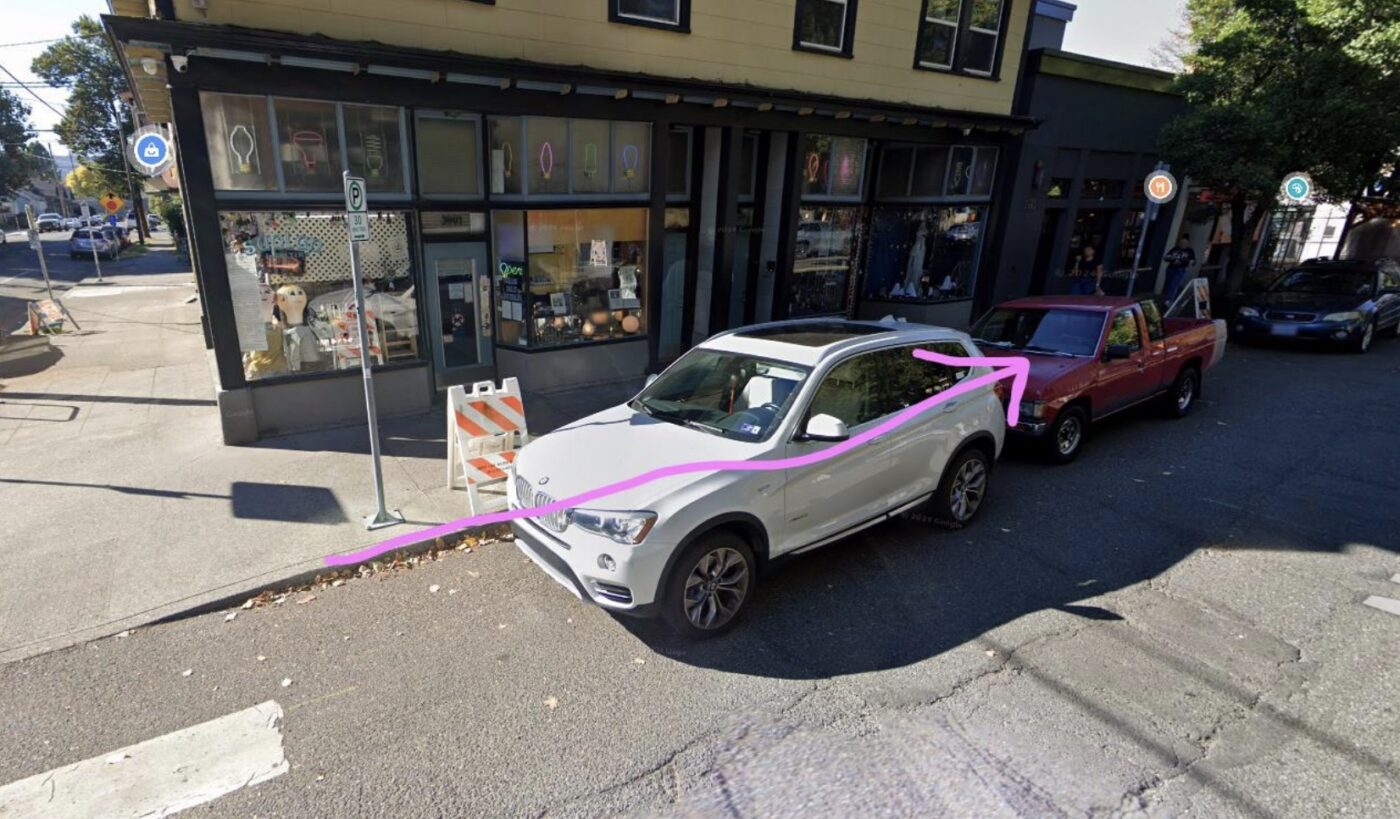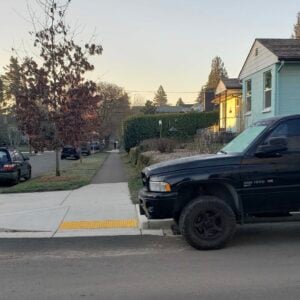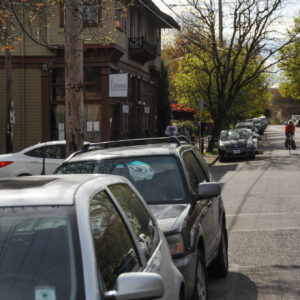Staff from the Portland Bureau of Transportation have revealed more details about their efforts to prohibit car parking at intersections.
At a meeting of the city’s Pedestrian Advisory Committee on March 18th, PBOT said they plan to implement “vision clearance” (their term for daylighting) standards at 200 intersections over the next two years. When I reported on this last month, all we had was the number of intersections and a timeframe. At the meeting last week, staff added that they have $200,000 to spend on the installations and that they expect to have all of them done this year.
New details revealed at the meeting include:
- Of the $200,000 budget, $50,000 comes from the Fixing Our Streets (FOS) program (revenue fro local gas tax). That means locations of those intersections must be spread evenly across the four council districts. FOS has $70.5 million allocated for its 2024-2028 project list. The daylighting projects will come out of the $6 million Safety on Neighborhood Streets spending category, so that means at least one of the cross streets of these 50 locations must be a local street classification.
- In a presentation PBOT shared with the Pedestrian Advisory Committee, they showed a few slides that are examples of locations they’re considering: N Mississippi Ave and N Failing St., NE Alberta Street and NE 16th Ave., NE Alberta Street and NE 16th Ave., and SE Belmont and SE 34th.
- The remaining $150,000 will come from the city’s General Fund, so there are no location restrictions on 150 of the intersections.
- PBOT will focus treatments on pedestrian districts that are also business districts. These are places where a busy street intersects with a local (residential street). Additional priority will be on locations where the side street is already a designated neighborhood greenway/walkway and where there’s an existing marked crosswalk.
- Intersections near schools will be a prime target. PBOT is already doing outreach to schools and will do a small educational campaign (lawn signs at corners) to explain why parking is being restricted.
- PBOT plans to clear two or four spots at each intersection, with a maximum of one parking spot at each corner. Many installations will remove just one parking spot at two corners (see diagram).
- Cost for each intersection is about $700-$800 in materials and labor (PBOT says they might be able to do more than 200 intersections with this first tranche of funding).
The practice of daylighting is a standard and proven road safety measure. When people choose to park their cars (especially larger ones) close to the corner it makes it harder for other road users to see cross traffic. Daylighting is especially popular among folks who aren’t inside cars because the risk of injury (or worse) from a collision is far greater when not wrapped by a metal cage.
Once completed, this work will help PBOT answer critics who say they haven’t moved fast enough on daylighting since making it a pillar of their Vision Zero strategy years ago. In 2020, PBOT was sued by a man who was injured in a collision while biking on SE Ankeny and his lawyers said the city was partly liable because they didn’t prevent drivers from parking all the way up to the corner.
The next step in this process is to identify which locations need daylighting the most. If you have ideas, email them to visionzero@portlandoregon.gov.
Learn more at PBOT’s vision clearance website.







Thanks for reading.
BikePortland has served this community with independent community journalism since 2005. We rely on subscriptions from readers like you to survive. Your financial support is vital in keeping this valuable resource alive and well.
Please subscribe today to strengthen and expand our work.
I look forward to cars inevitably parking there anyway
Delivery drivers most likely. To be fair, the area needs more designated 5 minute parking spots for them. PBOT could always install plastic bollards, they’ve done this at some locations already.
Nobody can park a car or delivery truck in these locations if bike corral style on street bike parking is also installed which wouldn’t significantly obstruct drivers view of the intersection. Bike corrals next to intersections and mid-block crosswalks worked well in Seattle and are usually significantly less expensive than curb bulbs.
There’s still going to be hate for taking from cars and giving to bikes just like when bike lanes are a part of a road diet on routes that don’t make sense for cyclists (like steep hills with better alternatives). Unfortunately PBOT would definitely claim that the expense was for bike infrastructure and redirect funds from other “bicycle infrastructure” projects.
Would it make sense to install a bike corral in locations without much demand for bike parking?
As someone who delivers food on their bike, yes, we need more bike parking everywhere.
If you were delivering food on your bike in a residential neighborhood, would you really lock your bike up in a corral a block away from your delivery address and walk the last couple of hundred feet with your delivery?
I’m not someone who delivers food on my bike, but I am nearly positive I wouldn’t. When I’m dropping off or picking something up I ride just as close as possible to my destination, including up the walkway where possible.
I’ve never seen you while you’re out making deliveries, but I’d be shocked if you didn’t do the same.
It’s frustrating that people can’t make even the most innocuous comments here without them getting picked apart for reasons straying further and further from the main point of the topic.
This is clearly one of Portland’s speedier projects – it will only take 180 years to fix all 18,000 city intersections at 100 per year.
Oregon laws OR 811.550 and 811.555 specifically ban parking within 20 foot of an intersection and crosswalk. The law also states it is an offense to park in a bike lane or on a sidewalk. I frequently encounter both riding around Portland and conclude that without enforcement it’s pointless.
That came up in an earlier article about daylighting intersections. There’s another Oregon law that allows individual jurisdictions to have their own traffic codes (which Portland does). I asked PBOT if the State law applies in Portland, but is simply not enforced, or does it actually not apply? PBOT said it does not apply, because Portland’s code supercedes it.
In regard to parking in bike lanes, I recall that Oregon has several exemptions that do allow it–for instance vehicles loading or unloading goods or passengers. BUT Portland’s code doesn’t have several of those exemptions.
“ban parking within 20 foot of an intersection and crosswalk.”
This does not apply in Portland. It’s not enforced because it’s not illegal.
I think it has far less to do with enforcement and far more to do with our unwillingness to heavily invest in bike infrastructure. Its hard for a car to park in a bike lane if there is a curb in the way.
Yes, because unenforced laws (i.e. every law in Portland) is not a law. It’s a polite request.
The state code that keeps getting cited does not apply to streets under city jurisdiction. This has been established many times. Please stop perpetuating this myth.
The state code that keeps getting cited does not apply to streets under city jurisdiction. This has been established many times. Please stop perpetuating this myth.
Well, they know where the bad ones are! Haha shooooot. Alberta/16th Belmont/34th Mississippi and failing (sunlan rocks!) are all on regular routes for me. They can use all the safety upgrades possible I swear. I used to ride ankeny daily but moved and since avoid it as much as possible going west because it’s easy to get moving and feels sketchy in too many places. My daylighting suggestions would be tillamook and Williams (hard to see south going west) Fremont/9th I think by Irving (favorite way to get to Irving and it’s still sketch) and it would be cool if the strange diverter on Williams past killingsworth didn’t feel like hazardous bottleneck, as well as the diverter on Rodney somewhere south of Alberta the gaps are small between the planters, enough that I would wonder if people on cargo bikes generally even try. I’m excited to see these improvements,,Thanks
Increase visibility AND parking capacity by changing the spaces to motorcycle/moped/bikeshare locations
$800 per intersection for… a bucket of paint that will last 6 months then look like shit for 10 years? That’s the Portland way.